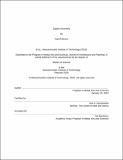| dc.contributor.advisor | Neil A. Gershenfeld. | en_US |
| dc.contributor.author | Falcone, Sara Elizabeth. | en_US |
| dc.contributor.other | Program in Media Arts and Sciences (Massachusetts Institute of Technology) | en_US |
| dc.date.accessioned | 2021-02-19T20:31:08Z | |
| dc.date.available | 2021-02-19T20:31:08Z | |
| dc.date.copyright | 2020 | en_US |
| dc.date.issued | 2020 | en_US |
| dc.identifier.uri | https://hdl.handle.net/1721.1/129871 | |
| dc.description | Thesis: S.M., Massachusetts Institute of Technology, School of Architecture and Planning, Program in Media Arts and Sciences, February, 2020 | en_US |
| dc.description | Cataloged from student-submitted PDF version of thesis. | en_US |
| dc.description | Includes bibliographical references (pages 70-71). | en_US |
| dc.description.abstract | Biology creates assemblies with orders of magnitude more parts than any known human designed process. Molecular biology functions on the premise that fundamental building blocks assemble into chains, are zipped into strands and folded into structures. This thesis is a macroscale implementation that aims to do the same, assemble, zip and fold, in an inorganic system. This system, Zipped, utilizes distributed coalescence of parts, aiming for faster assembly while incorporating error correction into the fabrication process. This thesis presents a design for 0-dimensional building blocks that snap together to form 1-dimensional strands. Strands zip together, interlocking to form 2-dimensional beams that can branch and merge to create patterns or flat sheets. Strands can zip to each other out of plane as well, allowing 3-dimensional construction. | en_US |
| dc.description.abstract | All steps of the construction process are reversible; parts can be assembled, dis-assembled and re-assembled without damage to the part or altering structural performance. No energy, formwork or pre-load is required to maintain the parts position once it is assembled. The system can assemble rigid as well as flexural elements, including chains and revolute joints. Increased stiffness or flexibility can be designed into structures by changing strand geometry and zipping. This ability to tune local structural properties allows actuators to be added to the construction system and form mechanisms. Zipped pieces are demonstrated as the structural element for a robot's body, which can locomote on itself or foreign terrain. Initial studies also demonstrate automated construction with this system. The fundamental principles of this system are demonstrated in many materials, via different manufacturing processes and across several scales, showing applicability to a diverse scenario space. | en_US |
| dc.description.abstract | For ease of fabrication and lab use a centimeter scale part was selected and several thousand parts were manufactured. This 0-dimensional part is presented and used to form larger scale assemblies which are mechanically characterized. From here, mission architectures and real-world applications are described. The Zipped system enables human-scale, controlled and reversible assembly, zipping and folding. This allows reusability, reconfigurability and universality - attributes we often credit to nature. | en_US |
| dc.description.statementofresponsibility | by Sara Falcone. | en_US |
| dc.format.extent | 81 pages | en_US |
| dc.language.iso | eng | en_US |
| dc.publisher | Massachusetts Institute of Technology | en_US |
| dc.rights | MIT theses may be protected by copyright. Please reuse MIT thesis content according to the MIT Libraries Permissions Policy, which is available through the URL provided. | en_US |
| dc.rights.uri | http://dspace.mit.edu/handle/1721.1/7582 | en_US |
| dc.subject | Program in Media Arts and Sciences | en_US |
| dc.title | Zipped assembly | en_US |
| dc.type | Thesis | en_US |
| dc.description.degree | S.M. | en_US |
| dc.contributor.department | Program in Media Arts and Sciences (Massachusetts Institute of Technology) | en_US |
| dc.identifier.oclc | 1237637475 | en_US |
| dc.description.collection | S.M. Massachusetts Institute of Technology, School of Architecture and Planning, Program in Media Arts and Sciences | en_US |
| dspace.imported | 2021-02-19T20:30:38Z | en_US |
| mit.thesis.degree | Master | en_US |
| mit.thesis.department | Media | en_US |
